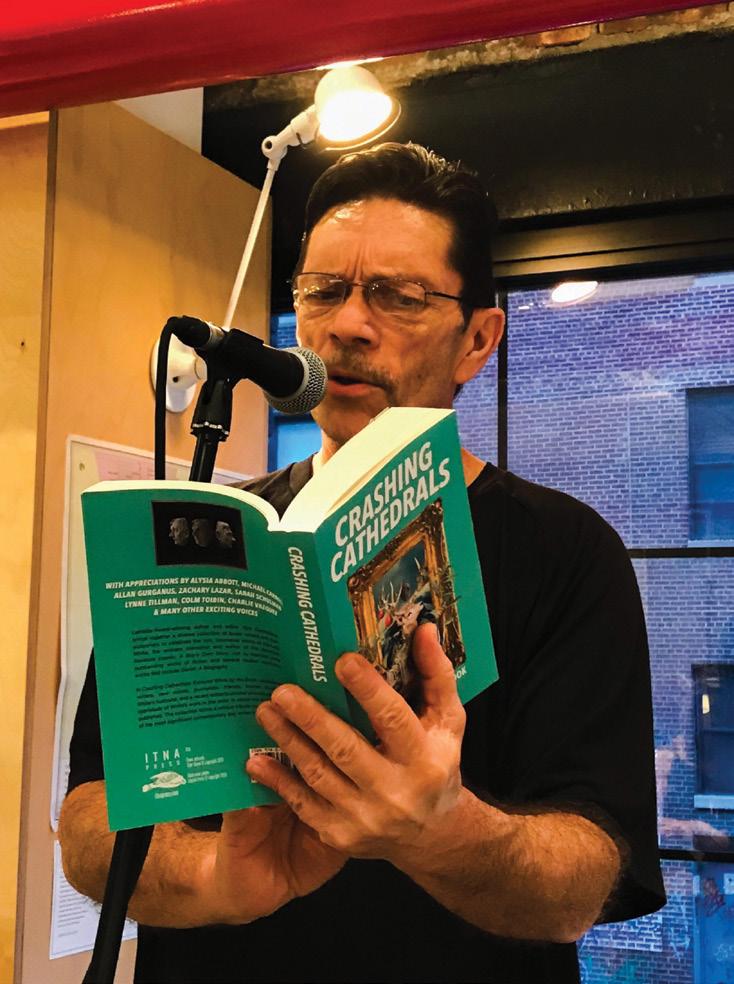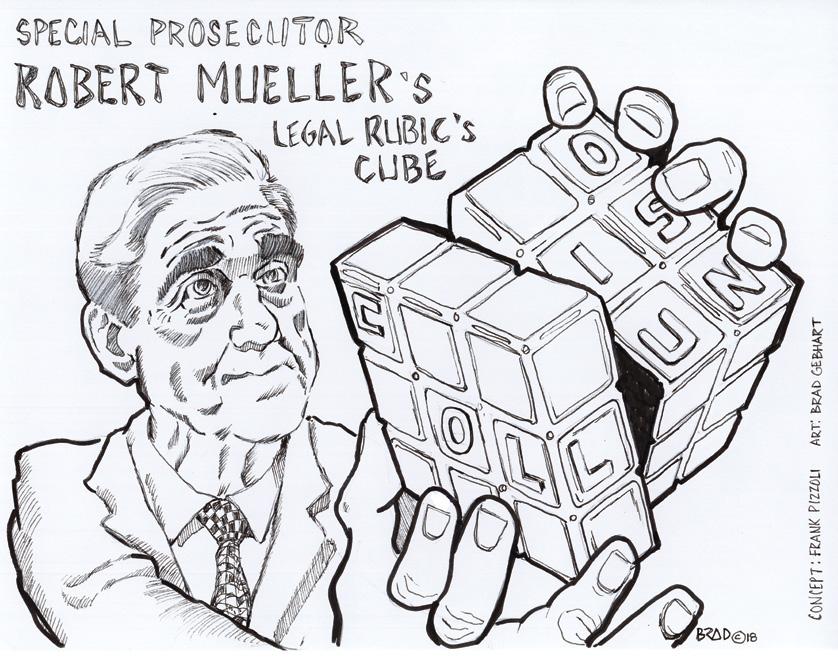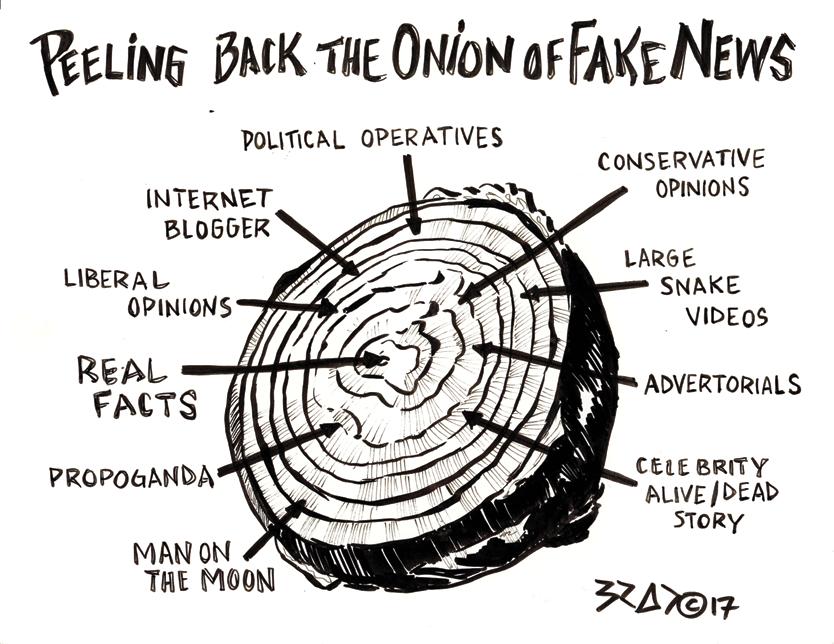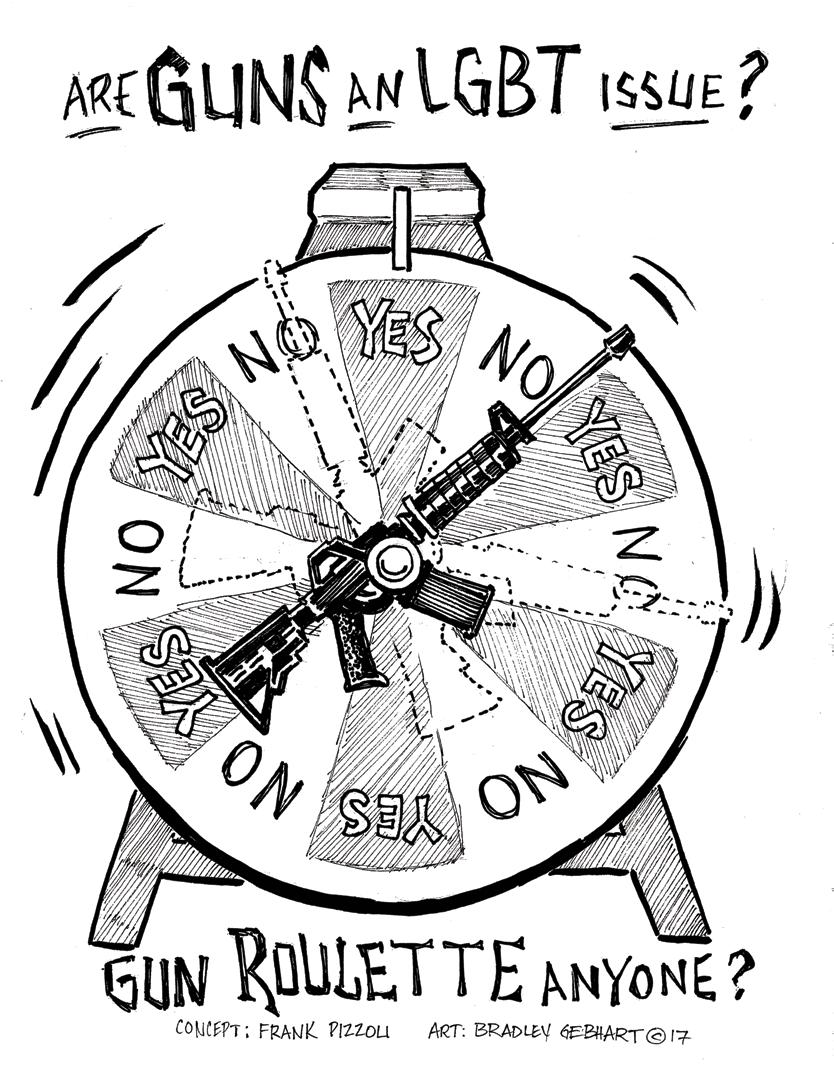
7 minute read
CARTOONING IS SEMISERIOUSE BUSINESS
Brad Gephart
Cartooning is Semi-Serious Business

By Jeff Falk Artwork Courtesy of Brad Gephart & Frank Pizzoli
Frank Pizzoli last May at Brooklyn’s McNally Jackson Bookstore reading from his chapter in Crashing Cathedrals: Edmund White by the Book.
There are few things more mentally stimulating or powerful than the interaction of words and images. But if a picture is worth a thousand words, then a political cartoon is worth its weight in gold. In good political cartoons, the words feed off the illustrations and the illustrations feed off the words, causing a mesmerizing presentation that has the ability to stop us in our tracks, for a good three seconds.
Political cartoons are designed to inform, entertain, educate and influence. They are social commentary seeking social justice, but one does not have to agree with the creator’s point of view to appreciate them.
Brad Gebhart and Frank Pizzoli practice the somewhat lost art of political cartooning, together. Pizzoli is the founding publisher and editor of the Harrisburg-based newspaper, The Central Voice, Central Pennsylvania’s LGBT (Lesbian, Gay, Bisexual, Transgender) News Source, and Gebhart doubles as a free-lance cartoonist.
Their political-cartoon collaboration, “From the minds of Brad and Frank,” appears on the op-ed page of every issue of the bi-monthly publication. Pizzoli has a lot of ideas bouncing around inside his brain, and Gebhart brings them to life, with the help of a pencil. “It is The Voice, with cartoons, and it’s a collaboration of words and pictures creating that voice,” says Gebhart. “We’re informing. We’re educating. We’re having fun. We’re not chastising. It’s our voice. And yeah, it’s our voice and we want to have an impact. I love it because it’s a collaboration, and we’re making an impact with art. We feel like we’re making some sort of changes.”
“What makes it more traditional is that it’s not grad-school cartooning,” adds Pizzoli. “We go back and forth until we’re



both satisfied – sometimes a hundred times. I, as often as I can, will take a national story and localize it, and if I can involve Brad I will. It’s about keeping Brad’s skills involved. It’s more than going on the internet and seeing what cartoons we can buy today. He becomes part of the entire editorial presentation.” While great minds might think alike, the beauty of Pizzoli’s and Gebhart’s creation is in the cooperation. Each brings his own unique skill set to the table, or living room floor, whichever the case may be at the time.
Pizzoli is the mastermind, wellversed and well-read. Gebhart is an accomplished artist and illustrator, who possesses the ability to put on paper what he sees in his imagination.
But make no mistake about the fact they are both political humans.
“That’s pretty much how it works,” says Pizzoli. “Concept by Frank Pizzoli, graphic by Brad Gebhart. We’ve branded it that way. I’ll go to Brad and ask, ‘How would you illustrate this? I’m primarily the idea guy, and he is the artist guy. But the process is back and forth. It wouldn’t work if we weren’t collaborating. I can’t draw. If I’m going to do it, I might as well write a story. Brad is the other side of the see-saw.”
“I’m not Brad the cartoonist,” says Gebhart. “It’s Brad and Frank doing cartoons. It wouldn’t exist without one or the other. It’s not just a string of cartoons in a newspaper, it’s collaboration. For me, artistically, the process is working. It’s another cup of coffee and a chat we can have. But I’m always trying to make it more entertaining, more fun. With art, each time is different.”
Over the last 12 years, Gebhart and Pizzoli’s collaborative efforts have produced some 72 political cartoons. Some of them have been national in scope, some have been more local or
regional in nature and some have commented on how national issues have affected local interests.
“In my mind, it’s taking a subject from the political arena, whether it’s an issue, a subject or something the president has done, and getting a message across,” says Gebhart. “It resonates, but it also tickles your funny bone. Words and images go together to make an impact. You want your audience to take a look and have an ‘Ah ha’ moment. My job is to illustrate Frank’s insight in a visual way, but I also want it to be a good drawing.”
“You don’t have to read it three times to see what we’re coming to you with,” says Pizzoli. “That’s where Brad’s talent comes in. The whole goal is that it won’t take you long to understand. The question is, ‘What is the nugget? What is the point we’re trying to make?’ And there might be a conclusion statement at the bottom.”
The roots of Gebhart and Pizzoli’s partnership were formed at a Central Pennsylvania Pride Festival along the Susquehanna River in the late 2000s, when a protestor got in Pizzoli’s face with a twisted finger. After that, the two discussed the possibility of collaborating for a political cartoon in The Central Voice. “Our back story is funny,” says Pizzoli. “I knew Brad was artistic. He was teaching art. When I approached him he said, ‘I do cartoons.’ That’s the way it got started. When we talked about it, it was like, ‘Let’s figure it out. Let’s do it.’ The first one was a version of that protest.”
“For me, my first recollection of being artistic was doing a little sculpture in kindergarten,” says Gebhart, the development director at Hamilton Health Center. “That and simple drawings of super heroes. But every time you talk to an artist, most will say they can’t remember their first day because they’ve always been drawing. And when an artist evolves, the art gets better. But I’ve always been into politics, interested in the news and what’s going on. I guess I’ve always wanted to be ‘in the know.’”
Gebhart and Pizzoli are constantly creating with their audiences in mind, and the public’s delight and acceptance of their political cartoons is simply affirmation that their collaboration works. Last year, their political cartoons were parts of exhibits at Susquehanna Art Museum and Lancaster Art Museum.
“Our goal is we want to be journalistic with the cartoons,” adds Pizzoli. “We hold the community to certain standards. First of all, we’re a newspaper. We do journalism. There might be times that we do stories that our community doesn’t like. It’s called The Central Voice because it aspires to give a voice to ideas, not just the LGBT community, but the community at large.” “The fact that our art work has ended up in two art museums shows it has value,” says Gebhart. “They’re taking on new life all the time. Frank and I see eye-to-eye on most things. When it comes to fruition it’s almost like a chef in a kitchen, and it’s on a plate perfectly seasoned, and the audience tastes it and they love it. I always like seeing it in the newspaper. But I know the process was fun.”
The ever-changing nature of politics – nationally, regionally and locally – assures Gebhart and Pizzoli will never be at a loss for topics for their cartoons. But that doesn’t mean they aren’t constantly re-thinking, re-assessing and re-inventing their collaboration. “What I enjoy is working with Frank,” says Gebhart. “It’s new. It’s real. It feels like we’re making a difference. For me, I feel like I’m making an impact. If we can change one mind, educate one person, we’ve done something important for our community.”
“At one point, we said, ‘How many of these have we done?,’” says Pizzoli. “It must be a bunch of them, because it works. We’ve pushed the ‘hold’ button and we’ve taken stock. We’ve asked ourselves, ‘Is it getting old? Is it getting old for the readers? Is it getting tired? Are we working in a way that’s getting boring?’ We’ve concluded, ‘If it ain’t broke, don’t fix it.’” 7












